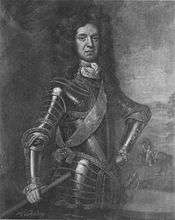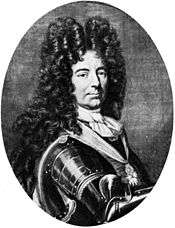Battle of Steenkerque
The Battle of Steenkerque (Steenkerque also spelled Steenkerke or Steenkirk) was fought on 3 August 1692, as a part of the Nine Years' War. It resulted in the victory of the French under Marshal François-Henri de Montmorency, duc de Luxembourg against a joint English-Scottish-Dutch-German army under Prince William of Orange. The battle took place near the village of Steenkerque in the Southern Netherlands, 50 kilometres (31 mi) south-west of Brussels. Steenkerque is now part of the Belgian municipality of Braine-le-Comte.
| Battle of Steenkerque | |||||||
|---|---|---|---|---|---|---|---|
| Part of the Nine Years' War | |||||||
| |||||||
| Belligerents | |||||||
|
|
| ||||||
| Commanders and leaders | |||||||
|
|
| ||||||
| Strength | |||||||
| 80,000 | 80,000 | ||||||
| Casualties and losses | |||||||
| 8,000 killed and wounded[2] | 10,000 killed and wounded[2] | ||||||

Prelude
The French had achieved their immediate object by capturing of Namur. The French, not wishing to fight, took up a strong defensive position in accordance with the strategical methods of the time. The French army lay facing north-west with its right on the Zenne at Steenkerque and its left towards Enghien. Their supposition was that the enemy would not dare to attack it.
William III had replaced Waldeck as supreme allied commander. The allied army was encamped about Halle. Of the 20 British regiments in the Allied army, 8 were Scottish, including the famed Mackay Regiment, who had landed with William at Torbay in 1688. The Allies, who would otherwise probably have done as the French marshal desired, were by the fortune of war afforded the opportunity of surprising a part of the enemy's forces. Accordingly, William set his army in motion before dawn on 3 August and surprised the French right about Steenkerque. He completely misled the enemy by forcing a defected spy to give Luxemburg false news. In the 17th century when the objects of a war were, as far as possible, secured without the loss of valuable lives and general decisive battles were in every way considered undesirable, a brilliant victory over a part, not the whole, of the enemy's forces was the tactical idea of the best generals.
Battle

The Allied advanced guard of infantry and pioneers, under the Duke of Wurttemberg, deployed silently around 5:00 a.m. close to the French encampments. Luxembourg was taken by surprise, allegedly because an attack on such a strong position seemed so unlikely; the main body of the French army was farther back and forming up after the passage of some woods. However, the extremely experienced Comte de Montal held off the initial Allied attack long enough to enable Luxembourg to bring up his main force.[3]
The march of the Allies' main body was mismanaged. Valuable time was lost. At 9:00 a.m. Wurttemberg started methodically cannonading the enemy while waiting for support and for the order to advance. The French worked with feverish energy to form a strong and well-covered line of battle at the threatened point. The allied main body had marched in the usual order with one wing of cavalry leading, the infantry following, and the other wing of cavalry at the tail of the column. On arrival at the field they were hastily sorted out into infantry and cavalry, for the ground was only suitable for the former.
Only a few Allied battalions had come up to support the advanced guard when the real attack opened at 12:30. Although the advanced guard had already been under arms for nine hours and the march had been over bad ground, its attack swept the first French line before it.
The English and Danes stubbornly advanced and the second and third lines of the French infantry gave ground before them. However, Luxembourg was rapidly massing his whole force to crush them. During this time the confusion in the allied main body had reached its height.

Count Solms ordered the cavalry he commanded forward, but the mounted men, scarcely able to move over the bad roads and heavy ground, only blocked the way for the infantry. Some of the British foot, with curses upon Solms and the Dutch generals, broke out to the front, and Solms, angry and excited, thereupon refused to listen to all appeals for aid from the front. No attempt was made to engage and hold the centre and left of the French army, which hurried, regiment after regiment, to take part in the fighting at Steenkerque. William's counter-order that the infantry was to go forward, the cavalry to halt, was opposed by General Hugh Mackay, who urged an ordered withdrawal, to effect a consolidation of the infantry. When directly ordered by William to advance he reportedly said "the will of the Lord be done", and was killed at the head of the Mackay Regiment, men of his own clan, after taking his place, on foot, at their head.
At the crisis Luxembourg had not hesitated to throw the whole of the French and Swiss guards into the fight, led by the princes of the royal house. More and more French troops under command of Boufflers appeared from side of Enghien. During and after this supreme effort the Allies were driven back, contesting every step against the weight of numbers.
The foot and dragoons of the main body which succeeded in reaching the front, served only to cover and to steady the retreat of Wurttemberg's force. The coup having manifestly failed, William ordered a general retreat. The Allies retired as they had come, their rear-guard under the Dutch Marshal Ouwerkerk showing too stubborn a front for the French to attack. The French army, very disordered and suffering heavy casualties, was in no state to pursue.
Aftermath
Over 8,000 men out of only about 15,000 engaged on the side of the Allies were killed and wounded. The losses of the French out of a much larger force were at least equal. Contemporary soldiers affirmed that Steenkirk was the hardest battle ever fought by the infantry in that war. Five British regiments were completely destroyed. Their commander, general Hugh Mackay, was also killed. Mackay's division, including the Mackay Regiment, composed of clansmen of his own name, bore the brunt of the day unsupported and the general himself was killed. John Cutts, was one of the few survivors.
The British blamed their great losses on the ineptitude of the Dutch general Count Solms in command of the Allied cavalry.
Steinkirk cravat
An article of dress was named after the battle. A "steinkirk" (also Steinquerque, Stinquerque in the mémoirs of Abbé de Choisy) was a lace cravat loosely or negligently worn, with long lace ends. According to Voltaire (l'Âge de Louis XIV), it was in fashion after the Battle of Steenkerque, where the French gentlemen had to fight with disarranged cravats on account of the surprise sprung by the Allies.
In popular culture
A French-speaking novel by Belgian journalist and author René Henoumont was published in 1979 under the title La maison dans le frêne (The House in the Ash tree), with the explanatory subtitle "ou la bataille de Steenkerque" (or the Battle of Steenkerque"). The work is organized in 12 parts, corresponding with the months of the year. Each part contains between 2 and 4 chapters. The narrator / author tells the reader about his (mostly autobiographical) life in the village of Steenkerque as he ponders life, nature, gardening and wars. In his silent dialogue with the nature around, the trees become the men who once waged war in this Belgian village.
Notes
-
- "...the standard of France was white, sprinkled with golden fleur de lis..." (Ripley & Dana 1879, p. 250).
- On the reverse of this plate it says: "Le pavillon royal était véritablement le drapeau national au dix-huitième siecle...Vue du chateau d'arrière d'un vaisseau de guerre de haut rang portant le pavillon royal (blanc, avec les armes de France)" (Vinkhuijzen collection 2011).
- "The oriflamme and the Chape de St Martin were succeeded at the end of the 16th century, when Henry III., the last of the house of Valois, came to the throne, by the white standard powdered with fleurs-de-lis. This in turn gave place to the famous tricolour" (Chisholm 1911, p. 460).
- Lynn 1999, p. 227
- Moreri, Louis (1749). Le grand dictionnaire historique ou Le melange curieux de l'Histoire sacrée; Volume I. Libraires Associes, Paris. p. 690.
References
| Wikisource has the text of the 1911 Encyclopædia Britannica article Steenkirk. |
- Chisholm, Hugh, ed. (1911). . Encyclopædia Britannica. 10 (11th ed.). Cambridge University Press. pp. 454–463.CS1 maint: ref=harv (link)
- Lynn, John A. (1999). The Wars of Louis XIV: 1667–1714. Longman. ISBN 0-582-05629-2.

- "The Vinkhuijzen collection of military uniforms: France, 1750-1757". New York Public Library. 25 March 2011 [2004]. Archived from the original on 6 April 2015.